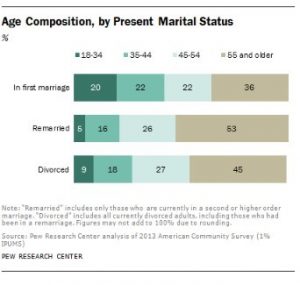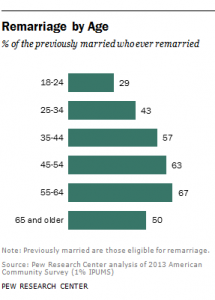34 Middle Adult Lifestyles
Singlehood
According to a recent Pew Research study, 16 per 1,000 adults age 45 to 54 have never-married, and 7 per 1,000 adults age 55 and older have never married in the U. S. (Wang & Parker, 2014). However, some of them may be living with a partner. In addition, some singles at midlife may be single through divorce or widowhood. Bella DePaulo (2014) has challenged the idea that singles, especially the always single, fair worse emotionally and in health when compared to those who are married. DePaulo suggests that there is a bias in how studies examine the benefits of marriage. Most studies focus on only a comparison between married versus not married, which does not include a separate comparison between those who have always been single, and those who are single because of divorce or widowhood. Her research, along with that of others, has found that those who are married may be more satisfied with life than the divorced or widowed, but there is little difference between married and always single, especially when comparing those who are recently married with those who have been married for four or more years. It appears that once the initial blush of the honeymoon wears off, those who are wedded are no happier or healthier than those who remained single. This might also suggest that there may be problems with how the “married” category is also seen as one homogeneous group.
Online Dating
Montenegro (2003) surveyed over 3,000 singles aged 40–69, and almost half of the participants reported their most important reason for dating was to have someone to talk to or do things with. Additionally, sexual fulfillment was also identified as an important goal for many. Alterovitz & Mendelsohn (2013) reviewed online personal ads for men and women over age 40 and found that romantic activities and sexual interests were mentioned at similar rates among the middle-age and young-old age groups, but less for the old-old age group.
Marriage

There has been a number of changes in the marriage rate as more people are cohabitating, more are deciding to stay single, and more are getting married at a later age. As you can see in Figure 5.34.1, 48% of adults age 45-54 are married; either in their first marriage (22%) or have remarried (26%). This makes marriage the most common relationship status for middle-aged adults in the United States. Marital satisfaction tends to increase for many couples in midlife as children are leaving home (Landsford, Antonucci, Akiyama, & Takahashi, 2005). Not all researchers agree. They suggest that those who are unhappy with their marriage are likely to have gotten divorced by now, making the quality of marriages later in life only look more satisfactory (Umberson, Williams, Powers, Chen, & Campbell, 2005).
Divorce
Livingston (2014) found that 27% of adults age 45 to 54 were divorced (see Figure 5.34.1). Additionally, 57% of divorced adults were women. This reflects the fact that men are more likely to remarry than are women. Two-thirds of divorces are initiated by women (AARP, 2009). Most divorces take place within the first 5 to 10 years of marriage. This time line reflects people’s initial attempts to salvage the relationship. After a few years of limited success, the couple may decide to end the marriage. It used to be that divorce after having been married for 20 or more years was rare, but in recent years the divorce rate among more long-term marriages has been increasing. Brown and Lin (2013) note that while the divorce rate in the U.S. has declined since the 1990s, the rate among those 50 and older has doubled. They suggest several reasons for the “graying of divorce”. There is less stigma attached to divorce today than in the past. Some older women are out-earning their spouses, and thus may be more financially capable of supporting themselves, especially as most of their children have grown. Finally, given increases in human longevity, the prospect of living several more years or decades with an incompatible spouse may prompt middle-aged and older adults to leave the marriage.
Gottman and Levenson (2000) found that the divorces in early adulthood were more angry and conflictual, with each partner blaming the other for the failures in the marriage. In contrast, they found that at midlife divorces tended to be more about having grown apart, or a cooling off of the relationship. A survey by AARP (2009) found that men and women had diverse motivations for getting a divorce. Women reported concerns about the verbal and physical abusiveness of their partner (23%), drug/alcohol abuse (18%), and infidelity (17%). In contrast, men mentioned they had simply fallen out of love (17%), no longer shared interests or values (14%), and infidelity (14%). Both genders felt their marriage had been over long before the decision to divorce was made, with many of the middle-aged adults in the survey reporting that they stayed together because they were still raising children. Only 1 in 4 regretted their decision to divorce.
The effects of divorce are varied. Overall, young adults struggle more with the consequences of divorce than do those at midlife, as they have a higher risk of depression or other signs of problems with psychological adjustment (Birditt & Antonucci, 2013). Divorce at midlife is more stressful for women. In the AARP (2009) survey, 44% of middle-aged women mentioned financial problems after divorcing their spouse, in comparison only 11% of men reported such difficulties. However, a number women who divorce in midlife report that they felt a great release from their day-to-day sense of unhappiness. Hetherington (Hetherington & Kelly, 2002) found that among the groups of divorcees she called the enhancers, those who had used the experience to better themselves and seek more productive intimate relationships, or the competent loners, those who used their divorce experience to grow emotionally, but who choose to stay single, the overwhelming majority were women.
Dating Post-Divorce
Most divorced adults have dated by one year after filing for divorce (Anderson et al., 2004; Anderson & Greene, 2011). One in four recent filers report having been in or were currently in a serious relationship, and over half were in a serious relationship by one year after filing for divorce. Not surprisingly, younger adults were more likely to be dating than were middle aged or older adults, no doubt due to the larger pool of potential partners from which they could to draw. Of course, these relationships will not all end in marriage. Teachman (2008) found that more than two thirds of women under the age of 45 had cohabited with a partner between their first and second marriages.
Dating for adults with children can be more of a challenge. Courtships are shorter in remarriage than in first marriages. When couples are “dating”, there is less going out and more time spent in activities at home or with the children. So the couple gets less time together to focus on their relationship. Anxiety or memories of past relationships can also get in the way. As one Talmudic scholar suggests “when a divorced man marries a divorced woman, four go to bed.” (Secombe & Warner, 2004).
Post-divorce parents gatekeep, that is, they regulate the flow of information about their new romantic partner to their children, in an attempt to balance their own needs for romance with consideration regarding the needs and reactions of their children. Anderson et al. (2004) found that almost half (47%) of dating parents gradually introduce their children to their dating partner, giving both their romantic partner and children time to adjust and get to know each other. Many parents who use this approach do so to avoid their children having to keep meeting someone new until it becomes clearer that this relationship might be more than casual. It might also help if the adult relationship is on firmer ground so it can weather any initial push back from children when it is revealed. Forty percent are open and transparent about the new relationship at the outset with their children. Thirteen percent do not reveal the relationship until it is clear that cohabitation and or remarriage is likely. Anderson and colleagues suggest that practical matters influence which gatekeeping method parents may use. Parents may be able to successfully shield their children from a parade of suitors if there is reliable childcare available. The age and temperament of the child, along with concerns about the reaction of the ex-spouse, may also influence when parents reveal their romantic relationships to their children.
Rates of remarriage
The rate for remarriage, like the rate for marriage, has been declining overall. In 2013 the remarriage rate was approximately 28 per 1,000 adults 18 and older. This represents a 44% decline since 1990 and a 16% decline since 2008 (Payne, 2015). Brown and Lin (2013) found that the rate of remarriage dropped more for younger adults than middle aged and older adults, and Livingston (2014) found that as we age we are more likely to have remarried (see Figure 5.34.2). This is not surprising as it takes some time to marry, divorce, and then find someone else to marry. However, Livingston found that unlike those younger than 55, those 55 and up are remarrying at a higher rate than in the past. In 2013, 67% of adults 55-64 and 50% of adults 65 and older had remarried, up from 55% and 34% in 1960, respectively.

Men have a higher rate of remarriage at every age group starting at age 25 (Payne, 2015). Livingston (2014) reported that in 2013, 64% of divorced or widowed men compared with 52% of divorced or widowed women had remarried. However, this gender gap has narrowed over time. Even though more men still remarry, they are remarrying at a slower rate. In contrast, women are remarrying today more than they did in 1980. This gender gap has closed mostly among young and middle aged adults, but still persists among those 65 and older.
In 2012, Whites who were previously married were more likely to remarry than were other racial and ethnic groups (Livingston, 2014). Moreover, the rate of remarriage has increased among Whites, while the rate of remarriage has declined for other racial and ethnic groups. This increase is driven by White women, whose rate of remarriage has increased, while the rate for White males has declined.
Success of Remarriage
Reviews are mixed as to the happiness and success of remarriages. While some remarriages are more successful, especially if the divorce motivated the adult to engage in self-improvement and personal growth (Hetherington & Kelly, 2002), a number of divorced adults end up in very similar marriages the second or third time around (Hetherington & Kelly, 2002). Remarriages have challenges that are not found in first marriages that may create additional stress in the marital relationship. There can often be a general lack of clarity in family roles and expectations when trying to incorporate new kin into the family structure, even determining the appropriate terms for these kin, along with their roles can be a challenge. Partners may have to navigate carefully their role when dealing with their partners’ children. All of this may lead to greater dissatisfaction and even resentment among family members. Even though remarried couples tend to have more realistic expectations for marriage, they tend to be less willing to stay in unhappy situations. The rate of divorce among remarriages is higher than among first marriages (Payne, 2015), which can add additional burdens, especially when children are involved.
Children’s Influence on Repartnering
Does having children affect whether a parent remarries? Goldscheider and Sassler (2006) found children residing with their mothers reduces the mothers’ likelihood of marriage, only with respect to marrying a man without children. Further, having children in the home appears to increase single men’s likelihood of marrying a woman with children (Stewart, Manning, & Smock, 2003). There is also some evidence that individuals who participated in a stepfamily while growing up may feel better prepared for stepfamily living as adults. Goldscheider and Kaufman (2006) found that having experienced family divorce as a child is associated with a greater willingness to marry a partner with children.
When children are present after divorce, one of the challenges the adults encounter is how much influence the child will have when selecting a new partner. Greene, Anderson, Hetherington, Forgatch, and DeGarmo (2003) identified two types of parents. The child- focused parent allows the child’s views, reactions, and needs to influence the repartnering. In contrast, the adult-focused parent expects that their child can adapt and should accommodate to parental wishes. Anderson and Greene (2011) found that divorced custodial mothers identified as more adult focused tended to be older, more educated, employed, and more likely to have been married longer. Additionally, adult focused mothers reported having less rapport with their children, spent less time in joint activities with their children, and the child reported lower rapport with their mothers. Lastly, when the child and partner were resisting one another, adult focused mothers responded more to the concerns of the partner, while the child focused mothers responded more to the concerns of the child. Understanding the implications of these two differing perspectives can assist parents in their attempts to repartner.
Grandparents
In addition to maintaining relationships with their children and aging parents, many people in middle adulthood take on yet another role, becoming a grandparent. The role of grandparent varies around the world. In multigenerational households, grandparents may play a greater role in the day-to-day activities of their grandchildren. While this family dynamic is more common in Latin America, Asia, and Africa, it has been on the increase in the U.S. (Pew Research Center, 2010).
The degree of grandparent involvement also depends on the proximity of the grandparents’ home to the grandchildren. In developed nations, the greater mobility of the society can mean that grandparents may live long distances from their grandchildren. Technology has brought grandparents and their more distant grandchildren together. Sorenson and Cooper (2010) found that many of the grandfathers they interviewed would text, email, or Skype with their grandchildren in order to stay in touch.

Cherlin and Furstenberg (1986) describe three styles of grandparents:
- Remote: Thirty percent of grandparents rarely see their grandchildren. Usually they live far away from the grandchildren, but may also have a distant relationship. Contact is typically made on special occasions, such as holidays or birthdays.
- Companionate: Fifty-five percent of grandparents were described as “companionate”. These grandparents do things with the grandchild but have little authority or control over them. They prefer to spend time with them without interfering in parenting. They are more like friends to their grandchildren.
- Involved: Fifteen percent of grandparents were described as “involved”. These grandparents take a very active role in their grandchild’s life. They children might even live with the grandparent. The involved grandparent is one who has frequent contact with and authority over the grandchild. Grandmothers, more so than grandfathers, play this role. In contrast, more grandfathers than grandmothers saw their role as family historian and family advisor (Neugarten and Weinstein, 1964).
Bengtson (2001) suggests that grandparents adopt different styles with different grandchildren, and over time may change styles as circumstances in the family change. Today more grandparents are the sole care providers for grandchildren, or may step in at times of crisis. With these changes grandparents are redefining how they see their role in the family with fewer adopting a more formal role (Hayslip, Henderson & Shore, 2003).
Early research on grandparents has routinely focused on grandmothers, with grandfathers often becoming invisible members of the family (Sorensen & Cooper, 2010). Yet, grandfathers stress the importance of their relationships with their grandchildren as strongly as do grandmothers (Waldrop et al., 1999). For some men, this may provide them with the opportunity to engage in activities that their occupations, as well as their generation’s views of fatherhood and masculinity, kept them from engaging in with their own children (Sorenson & Cooper, 2010). Many of the grandfathers in Sorenson and Cooper’s study felt that being a grandfather was easier and a lot more enjoyable. Even among grandfathers that took on a more involved role, there was still a greater sense that they could be more light-hearted and flexible in their interactions with their grandchildren. Many grandfathers reported that they were more openly affectionate with their grandchildren than they had been with their own children.
Friendships
Adults of all ages who reported having a confidante or close friend with whom they could share personal feelings and concerns, believed these friends contributed to a sense of belonging, security, and overall wellbeing (Dunér & Nordstrom, 2007). Having a close friend is a factor in significantly lower odds of psychiatric morbidity including depression and anxiety (Harrison, Barrow, Gask, & Creed, 1999; Newton et al., 2008). The availability of a close friend has also been shown to lessen the adverse effects of stress on health (Kouzis & Eaton, 1998; Hawkley et al., 2008; Tower & Kasl, 1995). Additionally, poor social connectedness in adulthood is associated with a larger risk of premature mortality than cigarette smoking, obesity, and excessive alcohol use (Holt-Lunstad, Smith, & Layton, 2010).

Female friendships and social support networks at midlife contribute significantly to a woman’s feeling of life satisfaction and well-being (Borzumato-Gainey, Kennedy, McCabe, & Degges-White, 2009). Degges-White and Myers (2006) found that women who have supportive people in their life experience greater life satisfaction than do those who live a more solitary life. A friendship network or the presence of a confidant have both been identified for their importance to women’s mental health (Baruch & Brooks-Gunn, 1984). Unfortunately, with numerous caretaking responsibilities at home, it may be difficult for women to find time and energy to enhance the friendships that provide an increased sense of life satisfaction (Borzumato-Gainey et al., 2009). Emslie, Hunt and Lyons (2013) found that for men in midlife, the shared consumption of alcohol was important to creating and maintaining male friends. Drinking with friends was justified as a way for men to talk to each other, provide social support, relax, and improve mood. Although the social support provided when men drink together can be helpful, the role of alcohol in male friendships can lead to health damaging behavior from excessive drinking.
The importance of social relationships begins in early adulthood by laying down a foundation for strong social connectedness and facilitating comfort with intimacy (Erikson, 1959). To determine the impact of the quantity and quality of social relationships in young adulthood on middle adulthood, Carmichael, Reis, and Duberstein (2015) assessed individuals at age 50 on measures of social connection (types of relationships and friendship quality) and psychological outcomes (loneliness, depression, psychological well-being). Results indicated that the quantity of social interactions at age 20 and the quality, not quantity, of social interaction at age 30 predicted midlife social interactions. Those individuals who had high levels of social information seeking (quantity) at age 20 followed by less quantity in social relationships but greater emotional closeness (quality), resulted in positive psychosocial adjustment at midlife. Continuing to socialize widely in one’s 30s appeared to negatively affect the development of intimacy, and consequently resulted in worse psychological outcomes at age 50.
Internet Friendships
What influence does the Internet have on friendships? It is not surprising that people use the Internet with the goal of meeting and making new friends (Fehr, 2008; McKenna, 2008). Researchers have wondered if the issue of not being face-to-face reduces the authenticity of relationships, or if the Internet really allows people to develop deep, meaningful connections. Interestingly, research has demonstrated that virtual relationships are often as intimate as in-person relationships; in fact, Bargh and colleagues found that online relationships are sometimes more intimate (Bargh, McKenna, & Fitsimons, 2002). This can be especially true for those individuals who are more socially anxious and lonely as such individuals are more likely to turn to the Internet to find new and meaningful relationships (McKenna, Green, & Gleason, 2002). McKenna and colleagues suggest that for people who have a hard time meeting and maintaining relationships, due to shyness, anxiety, or lack of face-to-face social skills, the Internet provides a safe, nonthreatening place to develop and maintain relationships. Similarly, Benford (2008) found that for high-functioning autistic individuals, the Internet facilitated communication and relationship development with others, which would have been more difficult in face-to-face contexts, leading to the conclusion that Internet communication could be empowering for those who feel frustrated when communicating face to face.
Workplace Friendships

Friendships often take root in the workplace, due to the fact that people are spending as much, or more, time at work than they are with their family and friends (Kaufman & Hotchkiss, 2003). Often, it is through these relationships that people receive mentoring and obtain social support and resources, but they can also experience conflicts and the potential for misinterpretation when sexual attraction is an issue. Indeed, Elsesser and Peplau (2006) found that many workers reported that friendships grew out of collaborative work projects, and these friendships made their days more pleasant.
In addition to those benefits, Riordan and Griffeth (1995) found that people who worked in an environment where friendships could develop and be maintained were more likely to report higher levels of job satisfaction, job involvement, and organizational commitment, and they were less likely to leave that job. Similarly, a Gallup poll revealed that employees who had close friends at work were almost 50% more satisfied with their jobs than those who did not (Armour, 2007).
Women in Midlife
In Western society, aging for women is much more stressful than for men as society emphasizes youthful beauty and attractiveness (Slevin, 2010). The description that aging men are viewed as “distinguished” and aging women are viewed as “old” is referred to as the double standard of aging (Teuscher & Teuscher, 2006). Since women have traditionally been valued for their reproductive capabilities, they may be considered old once they are postmenopausal. In contrast, men have traditionally been valued for their achievements, competence and power, and therefore are not considered old until they are physically unable to work (Carroll, 2016). Consequently, women experience more fear, anxiety, and concern about their identity as they age, and may feel pressure to prove themselves as productive and valuable members of society (Bromberger, Kravitz, & Chang, 2013).
Attitudes about aging, however, do vary by race, culture, and sexual orientation. In some cultures, aging women gain greater social status. For example, as Asian women age they attain greater respect and have greater authority in the household (Fung, 2013). Compared to white women, Black and Latina women possess less stereotypes about aging (Schuler et al., 2008). Lesbians are also more positive about aging and looking older than heterosexuals (Slevin, 2010). The impact of media certainly plays a role in how women view aging by selling anti-aging products and supporting cosmetic surgeries to look younger (Gilleard & Higgs, 2000).
Religion and Spirituality
Grzywacz and Keyes (2004) found that in addition to personal health behaviors, such as regular exercise, healthy weight, and not smoking, social behaviors, including involvement in religious- related activities, have been shown to be positively related to optimal health. However, it is not only those who are involved in a specific religion that benefit, but so too do those identified as being spiritual. According to Greenfield, Vaillant, and Marks (2009) religiosity refers to engaging with a formal religious group’s doctrines, values, traditions, and co-members. In contrast, spirituality refers to an individual’s intrapsychic sense of connection with something transcendent (that which exists apart from and not limited by the material universe) and the subsequent feelings of awe, gratitude, compassion, and forgiveness. Research has demonstrated a strong relationship between spirituality and psychological well-being, irrespective of an individual’s religious participation (Vaillant, 2008). Additionally, Sawatzky, Ratner, & Chiu (2005) found that spirituality was related to a higher quality of life for both individuals and societies.

Based on reports from the 2005 National Survey of Midlife in the United States, Greenfield et al. (2009) found that higher levels of spirituality were associated with lower levels of negative affect and higher levels of positive affect, personal growth, purpose in life, positive relationships with others, self-acceptance, environmental mastery, and autonomy. In contrast, formal religious participation was only associated with higher levels of purpose in life and personal growth among just older adults and lower levels of autonomy. In summary, it appears that formal religious participation and spirituality relate differently to an individual’s overall psychological well-being.
Age: Older individuals identify religion/spirituality as being more important in their lives than those younger (Beit-Hallahmi & Argyle, 1998). This age difference has been explained by several factors including that religion and spirituality assist older individuals in coping with age- related losses, provide opportunities for socialization and social support in later life, and demonstrate a cohort effect in that older individuals were socialized more to be religious and spiritual than those younger (Greenfield et al., 2009).
Gender: In the United States, women report identifying as being more religious and spiritual than men do (de Vaus & McAllister, 1987). According to the Pew Research Center (2016), women in the United States are more likely to say religion is very important in their lives than men (60% vs. 47%). American women also are more likely than American men to say they pray daily (64% vs. 47%) and attend religious services at least once a week (40% vs. 32%). Theories to explain this gender difference include that women may benefit more from the social-relational aspects of religion/spirituality because social relationships more strongly influence women’s mental health. Additionally, women have been socialized to internalize the behaviors linked with religious values, such as cooperation and nurturance, more than males (Greenfield et al., 2009).
Worldwide

To measure the religious beliefs and practices of men and women around the world, the Pew Research Center (2016) conducted surveys of the general population in 84 countries between 2008 and 2015. Overall, an estimated 83% of women worldwide identified with a religion compared with 80% of men. This equaled 97 million more women than men identifying with a religion. There were no countries in which men were more religious than women by 2 percentage points or more. Among Christians, women reported higher rates of weekly church attendance and higher rates of daily prayer. In contrast, Muslim women and Muslim men showed similar levels of religiousness, except frequency of attendance at worship services. Because of religious norms, Muslim men worshiped at a mosque more often than Muslim women. Similarly, Jewish men attended a synagogue more often than Jewish women. In Orthodox Judaism, communal worship services cannot take place unless a minyan, or quorum of at least 10 Jewish men, is present, thus insuring that men will have high rates of attendance. Only in Israel, where roughly 22% of all Jewish adults self-identify as Orthodox, did a higher percentage of men than women report engaging in daily prayer.
Media Attributions
- 080-MaritalStatusByAge © Pew Research Centre
- 080-RemarriageByAge © Pew Research Center
- 081-Grandparents © KAWILSON is licensed under a CC0 (Creative Commons Zero) license
- 076-WomenFriends3 © silviarita is licensed under a CC0 (Creative Commons Zero) license
- 99-WorkWomen(httpswww.piqsels.comenpublic-domain-photo-zkbbi)
- 082-Meditation is licensed under a CC0 (Creative Commons Zero) license
- 084-JewishMen © Steven DuBois is licensed under a CC BY-SA (Attribution ShareAlike) license

